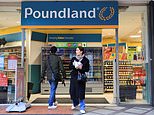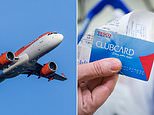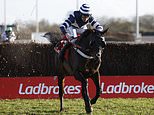Chart that reveals how new challenger banks lure in savers with best buy deals only to rein them in once they're established
- KPMG report shows how challengers fade away once established
- New entrants have 60 best buy savings rates in the tables
- This drops substantially depending on how long they've been around
Challenger banks are offering a raft of best buy savings deals when they first launch only to fade away once they have attracted enough cash from savers, data indicates.
Research shows that new small banks that have had a banking licence for under a year have 60 best buy savings rates currently on offer in Britain.
However, the chart below from KPMG and Savings Champion shows how this steadily falls the longer a challenger bank has been operating, suggesting they are enticing savers at the beginning with good rates to fill their coffers only to stop in subsequent years.

Challenger banks: Savings rates start to fade away once challengers are established, the report shows
For example, those that have had a licence for between one and three years have roughly half the number of best buy savings rates as newer players.
This drops substantially once a bank is more than four years old.
It comes as pre-tax profits for bigger 'challengers' such as TSB, Virgin Money, Metro Bank and Clydesdale and Yorkshire Bank rose £194million – or 18 per cent - to £1.28billion in 2015.
Last summer, short-term fixed rates received a boost as a number of new challengers battled to top the best buy savings tables in order to attract deposits which they then in turn lend out.
However, so far this year, these rates have fallen as the challengers filled their coffers in a time of lousy rates offered by the bigger high street names.
The big five – Barclays, HSBC Lloyds Banking Group, Royal Bank of Scotland and Santander collectively saw combined profits fall £5.6billion.
At present, most of the top deals are offered by challengers, especially new entrants such as online-only Atom Bank, alongside Ikano Bank.
However, others have faded away. For example, established 'challengers' Metro Bank and TSB don't make it in the independent This is Money tables for one-year fixed rates, offering just 1.1 per cent and 1.2 per cent respectively.
Susan Hannums, director at independent advice website Savings Champion, said: 'Recent years have been a golden age for challenger banks at a time when larger banks of almost disappeared from the savings best buy tables.
'It's been an opportune time to gain brand awareness whilst not competing with the high street providers. That said it's come at a price, as the more challenger banks that have come to the market has increased competition and in turn increased the rates needed in order to be in the best buy tables.
'The good news for savers is that these providers brought with them a new lease of life to the otherwise stagnant savings market and for most of 2015 they pushed rates back in the right direction.
'How sustainable this might be depends on the business models including what they may be charging on their loan books.
'The interesting change we're now seeing is that some challengers are trying to compete on more than just the rate for example service, technology and tapping into social media to gain customers. Time will tell if this or just simply the very best interest rate strategy wins overall.'


Faded away: TSB and Metro Bank are offering 12-month bonds which don't make it into the best buy tables
The UK Challenger Bank report from accountancy giant KPMG also cautioned over difficulties ahead for the sector's newer entrants, with conditions set to get more difficult amid a slowdown in buy-to-let lending after the recent stamp duty hike, as well as the Chancellor's new banking profit surcharge.
The report showed that buy-to-let lending was a major boost for challengers last year, accounting for around 15 per cent of their balance sheets.
However, recent trading updates from the sector showed there has been a major drop off in demand for buy-to-let borrowing since the April 1 increase in stamp duty, which is set to make 2016 a more difficult year for the challengers.
Shares for some of the listed challengers briefly fell by as much as 10 per cent after the buy-to-let changes on worries over its impact.
The report warned: 'Recent buy-to-let changes are unlikely to be the Achilles heel of challenger banks, but it indicates the tide is turning and goodwill towards challengers is waning.'
The new eight per cent surcharge on profits over £25million could also cost challengers dear, according to the research, which reveals it would have added an extra £70million to their tax bill if it had applied in 2015.
Warren Mead, head of challenger banking at KPMG, said while challenger banks are poised to gain further market share in 2016, they will have to start 'widening their nets and working harder' to compete.
He said: 'The challengers have grown up, and shouldn't expect significant assistance from regulators or policymakers. Several will also begin to really realise both the benefits and difficulties that being a large listed company brings.'
Most watched Money videos
- Volkswagen teases small and affordable ID.1 electric car
- TWISTED boss Charles Fawcett explains company's love for Land Rovers
- How to invest in credit for an 11% annual return
- One-of-a-kind Aston Martin offered for sale for the first time ever
- A look at the 'blisteringly fast' new Ferrari 12Cilindri Spider
- Octopus CEO: Regional electricity pricing can save the UK £51 billion
- Inside Britain's best-selling EV: The new Tesla Model Y
- Gen X falling behind on saving for retirement, research shows
- Kia launches its new eye-catching and stylish EV3 electric SUV
- The new two-door two-seater Aston Martin Vantage Roadste
- Bar manager and his husband feeling flush after winning OMAZE gem
- No taste buds no problem! Marks and Spencer launch wine AI tool
-
 Major bank set to pay customers £12.5m compensation after...
Major bank set to pay customers £12.5m compensation after...
-
 Volkswagen's affordable small EV: ID.1 will arrive in...
Volkswagen's affordable small EV: ID.1 will arrive in...
-
 Iconic UK chain with 825 stores put up for sale following...
Iconic UK chain with 825 stores put up for sale following...
-
 Are you putting your dog in danger in the car - and...
Are you putting your dog in danger in the car - and...
-
 Now Schroders urges Reeves to cut cash Isa limit - but...
Now Schroders urges Reeves to cut cash Isa limit - but...
-
 Three secrets to becoming an Isa millionaire revealed by...
Three secrets to becoming an Isa millionaire revealed by...
-
 Private parking firms make requests for car owner data...
Private parking firms make requests for car owner data...
-
 Poundland's owner Pepco considers selling struggling...
Poundland's owner Pepco considers selling struggling...
-
 How Tesco Clubcard users can bag 10,000 bonus points when...
How Tesco Clubcard users can bag 10,000 bonus points when...
-
 A third of drivers feel 'less safe' on smart motorways...
A third of drivers feel 'less safe' on smart motorways...
-
 ITV Studios scores record profits despite strikes hitting...
ITV Studios scores record profits despite strikes hitting...
-
 Reckitt hikes dividend for investors amid efficiency drive
Reckitt hikes dividend for investors amid efficiency drive
-
 MARKET WATCH: Melrose leads Footsie sell-off as US tech...
MARKET WATCH: Melrose leads Footsie sell-off as US tech...
-
 Admiral to hand share bonuses worth up to £3,600 to...
Admiral to hand share bonuses worth up to £3,600 to...
-
 Yet MORE rate cuts can't calm 'risky' eurozone, warns ECB...
Yet MORE rate cuts can't calm 'risky' eurozone, warns ECB...
-
 ITV proves the critics wrong: Shares may be up, but...
ITV proves the critics wrong: Shares may be up, but...
-
 Entain profits jump as digital gaming grows - but...
Entain profits jump as digital gaming grows - but...
-
 We're travel experts - here's your ultimate guide to...
We're travel experts - here's your ultimate guide to...











































